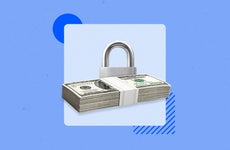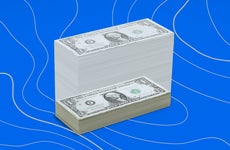Why now might be a good time to consider longer-term CDs

The Bankrate promise
At Bankrate we strive to help you make smarter financial decisions. While we adhere to strict , this post may contain references to products from our partners. Here's an explanation for .
As the Federal Reserve continues to hold on raising interest rates, you can still get the highest five-year CD yields in more than a decade.
But your window on this opportunity could soon close as the Fed hints that it’ll start lowering interest rates as early as this summer.
Long-term CD rates might have peaked in October 2023
The Fed’s rate decisions indirectly affect CD yields. Since March 2022, the central bank has raised the federal funds rate 11 times — with several of the hikes being more aggressive at 50 and 75 basis points higher.
But with inflation finally cooling, there’s at least one future rate cut in the cards by the Fed.
CD yields have peaked and already have started to pull back, says Greg McBride, CFA, Bankrate chief financial analyst. “With the Fed done raising short-term interest rates, there’s no fuel to push CD yields higher,” McBride says.
The top-yielding 5-year CD rate right now has an annual percentage yield (APY) of around 4.6 percent. APYs that high haven’t been available in more than a decade.
So the opportunity to lock in a long-term yield this high doesn’t come around often.
8 reasons why now might be a good time to consider a longer-term CD
1. You have long-term money in a savings account
A Bankrate survey from March found that only 22 percent of Americans with short-term savings have a savings account with a yield of at least 4 percent APY. People with money in those high-yield accounts have likely seen their yield increase dramatically since around March 2022, when the Fed started raising interest rates.
But if some of that is longer-term money — and rates do decrease in the future — you might be glad you opened a longer-term CD now.
2. You have funds you won’t need for a period of time
Having your emergency fund and other savings in a high-yield savings account is a good first step. But longer-term money might work better in a CD if you won’t need the money during the CD’s term. A CD can potentially help you earn a higher APY than a savings account, which generally has a variable APY. Another benefit of a CD over a savings account is if the Fed eventually lowers rates, your savings APY will likely decrease. But your regular CD has a fixed APY for the term of the CD.
Make sure you won’t need these funds during your CD term. Otherwise, you could incur an early withdrawal penalty. You could consider a no-penalty CD for funds that you think you might need during a CD’s term.
3. CDs offer a guaranteed return
There are few guarantees in life. But money in a CD — as long as it’s within the FDIC’s limits and following the FDIC’s rules — is protected from a bank failure and will earn a guaranteed APY, as long as you keep the money in the CD for the entire term.
“If you’ve had your eye on a CD, and especially one of the multi-year maturities, this is the time to lock in — they won’t get better by waiting,” McBride says.
4. Five percent is an attractive yield for any investment
During more normal times, a 2 or 3 percent yield would likely be close to keeping up with inflation.
“Even in the grand scheme of other investment classes and investment categories, a 5 percent return is a pretty strong return,” says Adam Stockton, director at Curinos, a data provider. “I think from that side, the downside risk of putting money into a CD is almost certainly lower now than a year ago.”
You can find 18-month CDs yielding up to 5.04 percent APY. But top longer-term CDs are earning yields lower than this, as high as 4.55 percent APY.
5. Long-term CD yields are good options if you think rates will come tumbling down soon
You shouldn’t try to time the market. And you shouldn’t try to find the absolute perfect time to deposit money into a new CD.
People need to ask themselves whether they’d feel more burned missing out on 6 percent APYs or missing out on 5 percent APYs, Stockton says.
But one thing is clear: None of us can with 100 percent certainty predict the future path of rates. Just look at the surprise stemming from the pandemic — where rates dropped to near-zero levels very quickly — as just one example.
You could consider a bump-up CD if you didn’t want to miss out on the potential for CD APYs increasing more.
6. A CD ladder could be beneficial in this environment
A CD ladder is a great way to spread CD maturities out over time with different terms of CDs. Traditionally, in your typical ladder, five-year CDs have a higher yield than one-year CDs.
But these days, you’re likely to see a CD with a term of around six months to 18 months will likely have the highest yield in your ladder.
7. Earn a market-like return without market risk
Securing a fixed APY during your CD term and getting Federal Deposit Insurance Corp. (FDIC) insurance coverage are two ways that a CD offers you guarantees. And these days, you can get a competitive return with a CD, too.
“Overall, a 5 percent return is what a lot of people suggest is kind of a benchmark for an overall investment portfolio,” Stockton says. “So hey, if you can get that return on just the cash for your portfolio, that’s a pretty good deal.”
With FDIC insurance, always make sure you are within the FDIC limits and following the FDIC’s rules.
8. You’re retired, or about to retire
People who are already retired – or retiring in the near future – should consider a CD and lock in a rate now. That way they can potentially keep up with or even be ahead of long-term inflation. There’s no guarantee that inflation will stay at elevated levels, however. It could increase or decrease in the future.
Bottom line
A long-term CD can be a good fit for money that you won’t need during the CD’s term. Locking in a longer-term CD now could help you preserve purchasing power if rates were to drop in the future. But depending on your risk tolerance and time horizon, there are other types of investments that might align better with your financial goals.
Related Articles



